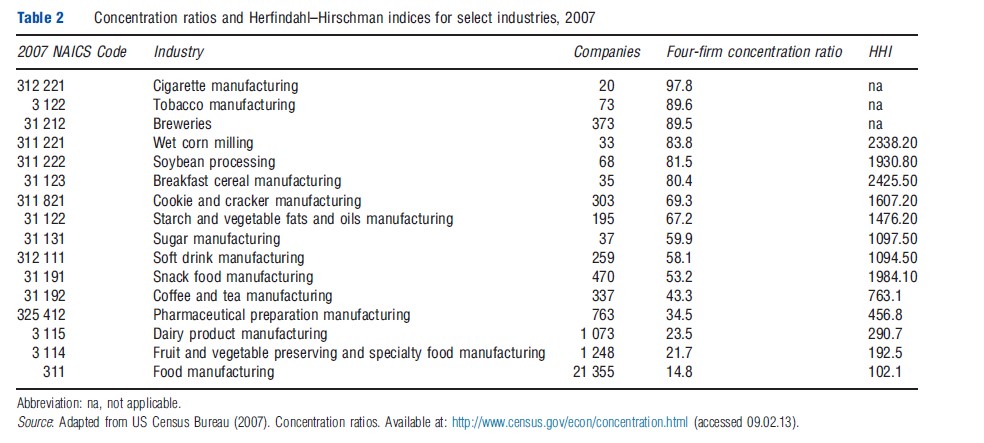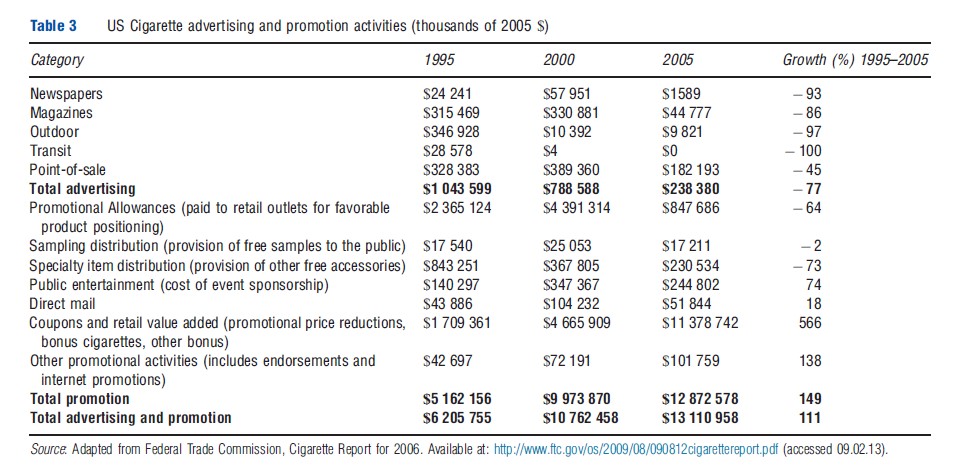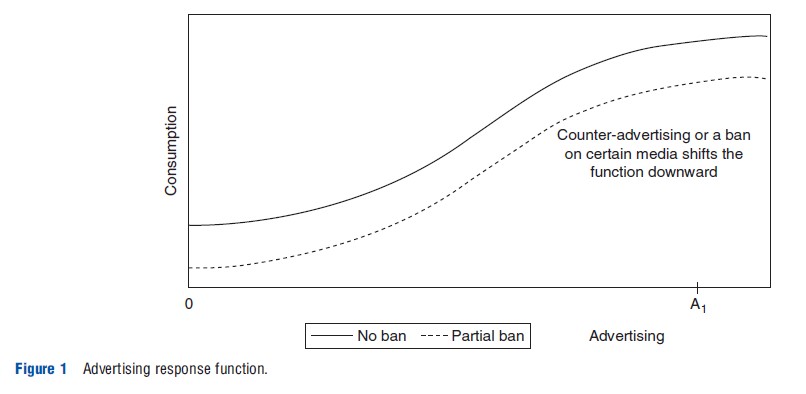Advertising In Health Markets
Tables 1 and 2 suggest that, with the exception of restaurants that tend to be more monopolistically competitive, industries that more heavily advertise generally tend to be more concentrated, with Herfindahl–Hirschman indices of at least 1000 (characteristic of mild concentration) or four-firm concentration ratios of at least 80% (characteristic of very concentrated industries). Scale economies in advertising exist, and larger firms are better able to spend on advertising. Studies by Kaldor and Silverman (1948) and Doyle (1968) supported the notion that advertising intensity and concentration are highly linked, leading to an oligopolistic structure (Bagwell, 2007). Nelson (1975) found a significant relationship between advertising intensity and concentration for search goods but not for durable goods or nondurable experience goods. The markets for tobacco, alcohol, food, soft drink, weight loss products, and prescription drugs are analyzed below in more detail.

Advertising Of Tobacco
Rather than compete directly on price, firms in highly concentrated industries such as the cigarette industry often use advertising to differentiate their brands and increase sales. In 2005, cigarette manufacturers spent $13.1 billion (or approximately 10% of their sales) on advertising and promotion, making cigarettes among the most heavily advertised and promoted products in the US. As reported in Table 3, this level also represents a 111% increase in total marketing expenditures over the past decade. Cigarette manufacturers had relied heavily on television advertising in the 1960s, though the application of the Fairness Doctrine to cigarette advertising in 1967 and the mandated antismoking messages subsequently reduced the commercial value of televised ads. Following a voluntary industry ban in 1970, cigarette broadcast advertising was officially banned by the Public Health Cigarette Smoking Act starting in 1971. Advertising practices were further restricted by the 1998 Tobacco Master Settlement Agreement (MSA), which also banned most forms of outdoor advertising. Cigarette advertising in magazines with youth readership increased dramatically post-MSA, but then later fell after public pressure (Hamilton et al., 2002) (also see Table 3). Since 1970, and particularly accelerating after the MSA, firms’ total marketing budget has shifted away from media-based advertising in favor of other promotional activities (such as coupons, added bonuses, promotional allowances, and event sponsorships). There was also a proliferation of cigarette brands over this period in an effort by firms to segment the market and thereby enhance their monopolistic power. The Family Smoking Prevention and Tobacco Control Act, signed into law in 2009, currently gives the Food and Drug Administration (FDA) authority to regulate the content, marketing, and sale of tobacco products.

Saffer (2000) noted that advertising by the cigarette industry is ‘‘designed to create a fantasy of sophistication, pleasure, and social success’’ and generate a product personality that will appeal to specific market segments. In other words, such advertising contains persuasive attributes and could raise demand by generating potentially spurious brand differentiation. Consistent with this persuasive view of advertising, Brown (1978) found decreasing average costs and increasing returns to advertising capital with sales, implying that advertising potentially creates substantial barriers to entry in the cigarette industry.
Given the external costs of smoking and related public health concerns, the key debate has understandably centered on whether and the extent to which cigarette advertising and promotion raise total cigarette consumption and expand the overall market. There is a large literature that has evaluated the effects of tobacco advertising and promotion on consumption outcomes. Rather than survey this literature (Chaloupka and Warner, 2000), the main findings and issues that have emerged from these studies are reviewed below. Empirical studies have been challenged in trying to isolate a marginal change in consumption when advertising and promotional activities of tobacco companies are at or close to the point of saturation (Ross and Chaloupka, 2002) and have produced mixed findings. Consider the advertising response function shown in Figure 1, which can apply to the national or local market level, and to the industry as a whole or at the brand level. Because of diminishing marginal product, the function flattens out at some point and consumption becomes increasingly less responsive to advertising. Diminishing returns may be unavoidable because the effectiveness of additional advertising will decrease once the most responsive buyers have already been reached. In the context of the informative view of advertising, as an increasing number of potential buyers receive information regarding the advertised product, additional advertising is less effective because an increasingly greater proportion of individuals who are exposed to the ads are already familiar with the product.

Earlier studies generally relied on annual or quarterly aggregated data at the national level and find either no effects or very small positive effects of advertising on cigarette consumption. This is perhaps to be expected because loss of variance at such a high level of aggregation makes it difficult to reliably identify effects. As cigarettes are heavily advertised and promoted, the marginal product of aggregate national advertising (measured at a range around A1 in Figure 1) may be very small or zero. Estimates based on a single time-series of aggregate national data are also likely confounded with unobserved trends and the simultaneity between advertising and sales.
Subsequent studies based on local or individual-level cross-sectional or panel data are more indicative of advertising-induced primary market-expansion effects. These studies typically use local-level (for instance, gathered at the level of the state or metropolitan statistical area) advertising data, which have greater (and plausibly more exogenous) variation owing to differences in advertising costs across markets and because of pulsing (which is a burst of advertising, in a specific market, that lasts for a short time and then stops). Goel and Morey (1995), for instance, used annual state-level data spanning 1959–82 and found significant effects of lagged cigarette advertising on consumption. Roberts and Samuelson (1988) developed a model of non-price competition for an oligopolistic industry and applied it to their study of the cigarette market, utilizing data for six firms spanning 1971–82. They concluded that ‘‘advertising primarily affects the size of market demand and does not alter firm market shares’’ (p. 215). In a study using individual-level data on 6700 youth, combined with measures of televised cigarette advertising, counter-advertising, and self-reported time spent watching television, Lewit et al. (1981) found that smoking ads on television are significantly associated with higher youth smoking.
Studies that examine the impact of advertising bans provide further evidence on whether cigarette advertising expands the overall market. These studies also bypass some of the limitations stemming from the simultaneity between advertising intensity and sales. However, the passage of advertising restrictions may not be strictly exogenous and depends on past trends in smoking prevalence. If advertising only leads to brand-switching with no primary effects on market demand, then advertising restrictions should not have any effects on consumption. Banning advertising on certain media would potentially shift the advertising response function downward, as shown in Figure 1. Even if an advertising ban does not reduce the total level of advertising, it will reduce the average and marginal effectiveness of advertising as firms substitute from the banned media to the non-banned media. Increased use of non-banned media reduces average and marginal effectiveness because of diminishing marginal product. If firms try to compensate for the advertising ban by increasing total advertising expenditures, this would correspond with a movement to a higher level of advertising on the lower advertising response function in Figure 1. Table 3 provides some evidence that this may be the case for the cigarette industry. Consistent with an advertising-induced market expansion effect, Goel and Morey (1995) found that the broadcast ban on cigarette advertising lowered consumption. Saffer and Chaloupka (2000) studied the effects of tobacco advertising bans on tobacco consumption in 22 high-income countries over the period from 1970 to 1992. They found that although a limited set of advertising bans has little or no effect (because firms have many remaining media options), a comprehensive set of media bans can reduce tobacco consumption by 6–7%.
Cigarette brands may also have some credence attributes – wherein the consumer is not able to fully assess the product quality even after consumption. This can provide an incentive for firms to engage in potentially misleading advertising. For instance, the US Department of Justice maintained in a lawsuit filed in 1999 that the cigarette manufacturers falsely marketed and promoted their low-tar and light cigarette brands as being less harmful than conventional cigarettes. The consumer may be persuaded by these claims and would not be able to judge their veracity even post consumption at least over the short-term.
Given the possible market expansion effects of cigarette advertising and the presence of such misleading or imperfect product information, antismoking advertisements (or counter-advertising) have been undertaken by the public sector. Between 1967 and 1970, the Fairness Doctrine required broadcasters to donate air time to antismoking ads. At their peak, the ratio of antismoking ads to smoking ads was one third (Saffer, 2000). Funds from the 1998 Master Settlement Agreement further provided for many state-initiated antitobacco campaigns. Studies have generally found such counter-advertising to be effective in reducing cigarette consumption. Emery et al. (2005), for instance, studied individual exposure to antitobacco advertising across the largest 75 media markets in 48 states between 1999 and 2000. They concluded that state-sponsored counter-advertising is associated with greater antitobacco sentiment and reduced smoking among youth. Interesting content analyses by Goldman and Glantz (1998) have suggested that the most effective antismoking messages focus on the tobacco industry’s manipulation of its customers and the least effective are ads that portray smoking as unhealthy. This suggests that health-related messages currently may not be conveying any new information to consumers, and that the effectiveness of antismoking messages may derive from their directly counteracting the persuasive qualities of smoking ads and moderating the complementarity between smoking and smoking ads (for instance, through smoking ads portraying social prestige).
Advertising is also highly prevalent for products aimed at helping consumers quit smoking, such as nicotine-replacement therapy. Smoking-cessation products can be classified as experience goods because the consumer needs to use them before being able to assess their efficacy, and theory predicts a relatively high advertising intensity for experience goods. Avery et al. (2007) studied the market for such smoking cessation products and noted that the industry spent between 10% and 20% of its sales on advertising. They specifically studied the effects of magazine advertising of such products using individual-level data matched with salient individual-level measures of advertising exposure, paying careful attention to endogeneity concerns, and found that smokers who are exposed to more advertising are more likely to attempt to quit and are more likely to have successfully quit. Adopting the same identification strategy, Dave and Saffer (2013) also found that magazine advertising for smokeless tobacco (ST) products, which is one of the few conventional media available for manufacturers following bans in other media, leads to a higher probability of using ST. ST, which is safer than smoking though not completely safe, is also sometimes used as a cessation aid by smokers. Hence, the debate centers on the potential role of ST use and ST marketing as tools in an overall tobacco harm-reduction approach.
There is some indirect evidence on the competitive effects of advertising in the cigarette market. Brown (1978) found decreasing average costs and increasing returns to advertising, and concluded that advertising may create barriers to entry, based on data that preceded the 1970 television ban. Eckard (1991) utilized the television advertising ban as a natural experiment to study the effects of advertising, and found that concentration within the industry actually increased after the ban. This is in line with Thomas (1989), who found decreasing returns to scale with respect to advertising in the cigarette market, thus yielding a potential advantage to smaller firms with multiple brands. Indeed, the extent of brand proliferation and brand-level competition in the cigarette market is consistent with this finding.
In summary, the role of advertising in tobacco markets is controversial. The public health community contends that such advertising encourages smoking and particularly influences experimentation and smoking initiation among youth. The tobacco industry maintains that their advertising only affects selective demand through brand-switching and does not influence the overall size of the market. Manufacturers also suggest that their advertising provides important information content, for instance, regarding tar and nicotine (Chaloupka and Warner, 2000). Although earlier studies did not find significant market-level effects of cigarette advertising, more sophisticated analyses seem to indicate that advertising does impact primary demand. Further evidence gleaned from studies of advertising restrictions, antismoking ads, and advertising of smoking cessation products is also consistent with this market expansion effect. These studies also point to potential avenues through which advertising impacts the overall market demand, and these pathways are consistent with all three views of advertising discussed in Section ‘Conceptual Framework.’